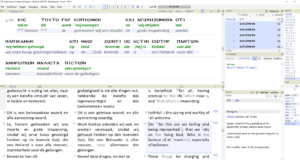Which Bible translation does GoedBericht.nl use?
26-05-2025 - Posted by Geert-JanOriginally posted on September 13, 2022 - by Andre Piet
Anyone who listens to the spoken studies on the GoedBericht site, or reads the articles published there, will quickly notice that frequent reference is made to the original text of the Bible. By this, we mean the (original) Hebrew and Greek text on which Bible translations are based. In GB presentations, this is almost always referenced via an interlinear. Interlinear literally means “between the lines” and refers in this case to a word-for-word rendering displayed in lines beneath one another:
at the top, the Hebrew or Greek source text;
below that, a literal word-for-word translation;
and on the third line (typically), the way a common translation (in this case the NBG51) renders the word from the source text.

original vs. translation
Since GB holds that all the words of Scripture are “God-breathed” (inspired; 2 Timothy 3:16), it places great importance on staying as close as possible to the Source (text) and returning to it time and again. For it is the original text of Scripture that is inspired—not the translation. Every translation is the work of human hands and must therefore be approached critically.
concordant translation method
Because the words in the original text are leading, GB strongly endorses the so-called concordant translation method. This is a method that, as far as possible, is based on the concordance of the source text. A concordance, in general, is an alphabetical reference work listing where specific words can be found. A concordance on the original text lists all the words from the Hebrew and Greek Scriptures.
The concordant translation method aims to assign each word in the source text a consistent (concordant = uniform) translation equivalent. The goal is that each translated word points one-to-one to a specific word in the original.
To cite the most well-known example from the GB website: the Greek word aion should be rendered uniformly (concordantly), and not—as is common in traditional Bible versions—translated sometimes as “age” (eeuw) and other times as “eternity” (eeuwigheid, without beginning or end). That is discordant (= non-uniform) and unnecessarily alienates readers from the vocabulary of Scripture.
limits of concordance
In all fairness, a qualification must be made here. While the concordant translation method may be the ideal, it is by no means always attainable. Even if a consistently one-to-one translation were (!) possible, it would, in practice, produce an utterly unreadable version. The idiom (linguistic character) of one language is never identical to that of another. This holds true even for related languages like Dutch and English—let alone for languages that are so far removed in both time and structure.
There is an immense gap between the Hebrew of the Tenach and our modern Dutch. And the same applies (albeit to a slightly lesser extent) to the Biblical Greek and our language. The grammar and syntax (word order) of both source languages differ drastically from Dutch. Not to mention that contemporary Dutch itself also differs significantly from the language of the Statenvertaling (Dutch Bible translation), completed in 1635.
no single concordant translation
Since no Bible translation is or can be entirely concordant, there is no such thing as the concordant Bible translation. Even within the Dutch-speaking world, several translations are available that each embrace the concordant translation method to varying degrees.
The Statenvertaling (1635) was strongly aligned with this principle—so much so that it familiarized the Dutch language with numerous typically Hebrew expressions. The Naardense Bijbel (2004) is also well-known, not only for its rather literal approach but also for its idiolect character, meaning it seeks to reflect the linguistic features of the source texts as much as possible. Also noteworthy is the Telos translation of the New Testament.
In recent years, there have been several independent efforts explicitly grounded in the concordant method. Notable among these are Schriftwoord (by Wim Janse) and especially Geschriften (by Menno Haaijman).
a concordant translation app
A new initiative is being offered by the NCV (by Thijs Amerfoort), which presents a concordant Bible translation in a free app, including an interlinear. It also provides many search options and information about words. A very promising project!
ISA by scripture4all
For over twenty years, I myself have been working on the gb site with what I consider the unsurpassed free interlinear Bible program: isa (interlinear scripture analyzer), from the website scripture4all. This work is primarily based on the concordant translation work published by concordant publishing concern. The scripture4all website also offers many articles on translation issues, grammar, word structure, etc.
ISA does not provide a Bible translation, but is an interlinear. As a software program, it includes many advanced features for word searches. The (unfortunately not yet freely available) option of a so-called concordant view makes the degree of concordance of translation words very transparent. During presentations, I almost always show images from this isa program, usually accompanied by a literal translation of my own. With the disclaimer that this translation is made purely for personal use.

 English Blog
English Blog